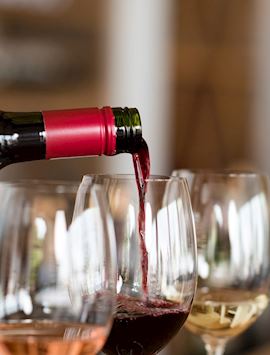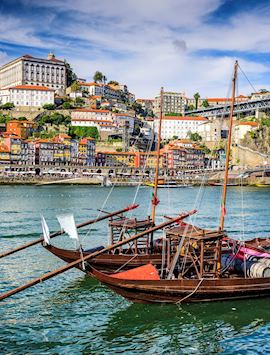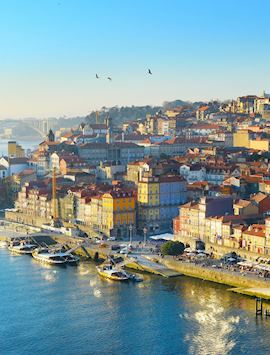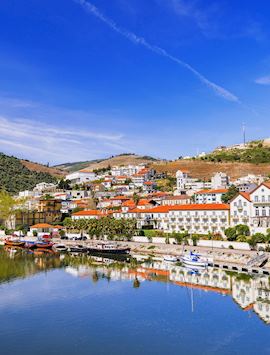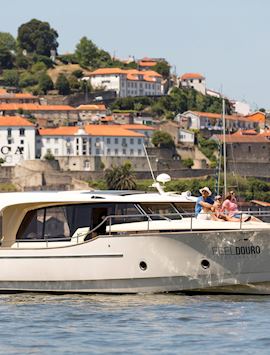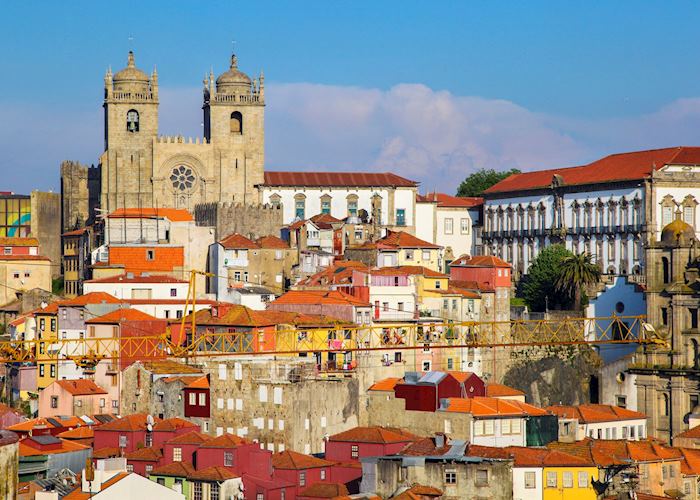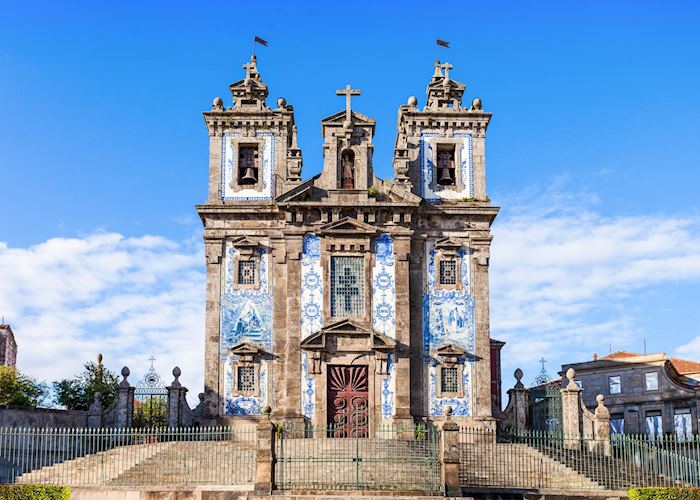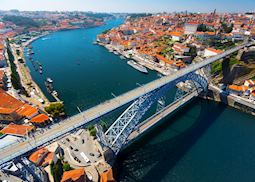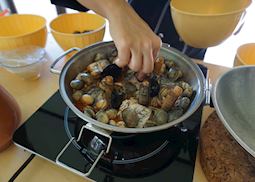Jump to:
Porto is Portugal’s compact and energetic second city, built on the steep banks of the mouth of the Douro River. It avoided the ravages of the 1755 earthquake that destroyed Lisbon, thus preserving its character and you’ll find brightly tiled, tight-knit houses crowding the slopes above the historic waterfront Ribeira district as well as a charmingly tumbled-down medieval core.
The Douro River — crossed by six bridges — was historically the region’s main artery. It runs from the inland wine country to the Vila Nova de Gaia parish, across the water from the main city. There, Porto’s eponymous fortified wine still ages silently in oak casks hidden in wine cellars, just as it has for hundreds of years.
Spain & Portugal specialist AllanPorto’s Old-World feel is obviously apparent along the riverfront but delving up into the heart of downtown you’ll find numerous beautiful tile-clad churches and elegant plazas.
Things to see and do in Porto
Ribeira district
On the north bank of the river, Ribeira is a photogenic district of medieval townhouses and small shops. The bank is lined with brightly tiled cafés that spill onto the grey flagstones, and behind this huddles a small warren of alleys little more than an arm span across, linked by steep steps and hidden from one another like the corridors in a maze containing some of Porto’s oldest buildings.
You can easily while away time here, admiring the Douro (Riberia literally means ‘riverside’) or meandering through the lanes away from the waterfront. Or, to get a different perspective on the city, board a cruise along the river to admire the river’s six bridges.
Douro bridges
The river is spanned by six bridges, most notably the Dom Luís I. A double-decker bridge, the main road follows the lower level or — to enjoy some good views of the river and city — you can travel across the upper level on the local metro system or on foot.
The Maria Pia Bridge, an elegant and airy construction of steel, is the oldest of the Douro’s bridges and was designed by none other than Gustave Eiffel.
The Arrábida Bridge once held the record for the longest arch in a concrete bridge. That has been surpassed, but it remains one of the major road routes between Porto and Vila Nova de Gaia.
Vila Nova de Gaia’s port wine cellars
Across the river from Ribeira, Vila Nova de Gaia is the home of the wine cellars where port is aged. A visit here is an essential part of understanding the region.
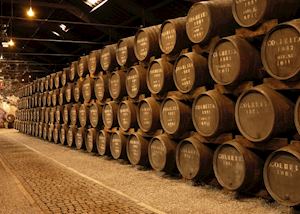 Port dates back to Great Britain’s 18th-century squabbles with France, when the British decided to buy their wine from Portuguese vineyards instead of Gallic ones. To preserve the red wine on the long voyage to London, vintners fortified their goods with brandy.
Port dates back to Great Britain’s 18th-century squabbles with France, when the British decided to buy their wine from Portuguese vineyards instead of Gallic ones. To preserve the red wine on the long voyage to London, vintners fortified their goods with brandy.
To this day, grapes for port are grown in terraced vineyards in a fixed area along the banks of the Douro River — the oldest demarcated wine region in the world and a UNESCO World Heritage Site. The wine is then shipped to Vila Nova de Gaia, where it’s spiked with brandy and aged in the cellars of the great houses like Cálem, Ferreira, Sandeman and Taylor’s.
The result is a sweet, rich after-dinner tipple best sipped from small glasses, the better to relish its bold, complicated taste. Many of the cellars offer tours, and are fronted by showrooms and exhibitions, with rows of tables for tastings afterward. You’ll be invited to try samples of the main types of port, including the youthful ruby varieties, and tawny port, which is aged for at least two years.
São Bento Railway Station
Completed in 1903, the São Bento Railway Station is a grand and graceful building that dates back to an era when train journeys were an elegant mode of travel. The stately façade is made from time-darkened granite, with a mansard roof and Beaux Arts clocks, but the real attraction is inside the front hall.
There, dominating three walls, more than 20,000 blue-and-white azulejo (tiles) depict both great moments in Portugal’s history and the evolution of transport. These hand-painted tiles were designed by Jorge Colaço over the course of 11 years.
Museu de Arte Contemporânea & Museu de Serralves
Porto’s preservation of its historic attractions doesn’t mean the city is mired in the past. Instead, it maintains a lively appreciation of contemporary architecture and art.
You can see the latter on display at the Museu de Arte Contemporânea, designed by native son Álvaro Siza Vieira. It’s a startlingly minimalist building with whitewashed galleries where you can see rotating exhibits of world-class contemporary art.
Its nearby sister museum, the Museu de Serralves, is a pink Art Deco mansion that displays site-specific work by the likes of Dan Graham, Richard Serra and Claes Oldenburg.
Both are set in the grounds of the Parque de Serralves, a whimsical garden of rose beds and formal fountains and giant sculptures, like a giant bright-red gardening trowel.
Torre dos Clérigos
For one of the best vantage points in Porto, we suggest climbing this Baroque tower, which stands 74 m (243 ft) above the streets. Getting to the top involves more than 200 tightly spiralled steps, but your efforts are rewarded with a bird’s-eye view over the tightly packed terracotta roofs of the city to the river and beyond.
You can visit exhibits on the first and second floors, which illuminate the history of the tower and its residents, as well as an associated church, the Igreja dos Clérigos. Both the tower and the church were designed in the mid-1700s by the same architect, Italian-born master Nicolau Nasoni.
Foz do Douro & Matosinhos
Located where the Douro meets the Atlantic, Foz do Douro (‘Foz’ to locals) is an upscale waterfront parish with enough attractions to support a day-long visit. You can admire the Atlantic from a lighthouse, stroll under the pergola on the waterfront esplanade or indulge in some ice cream on the wide, golden-sand beach.
Families, amblers and amateur botanists will enjoy the tree-canopied paths through the Jardim do Passeio Alegre, a garden that boasts several monuments and fountains, as well as crazy golf for the children.
Beyond Foz, Matosinhos is the city’s main fishing port, which means the local restaurants and cafés offer impeccably fresh seafood right off the boat. The beach here is Porto’s most consistent surfing destination, with regular but gentle waves.
At the southern reach of the parish, you’ll find SheChanges — Anemone, a fishing net sculpture that towers four stories high and undulates like an actual anemone in the constant ocean breezes. The net is a tribute to the area’s fishing heritage.
Best time to visit Porto
Spring months (March to May) bring warm breezes and sunshine to Porto, making it an ideal time to visit. September and October are also nice, with comfortable temperatures and fewer visitors. The heat and crowds both increase in the summer months (June to August), so we suggest avoiding those. Rains usually arrive in November and don’t leave until the end of February.
who's been there
-
01993 838 92501993 838 461
- Make an enquiry
Suggested itineraries featuring Porto
Our itineraries will give you suggestions for what is possible when you travel in Porto, and they showcase routes we know work particularly well. Treat them as inspiration, because your trip will be created uniquely by one of our specialists.
Places near Porto
- Braga & Guimarães 30 miles away
- Douro Valley 38 miles away
- Coimbra 67 miles away
- Sintra 168 miles away
- Estremadura 170 miles away
- Lisbon 171 miles away
- Belém 174 miles away
- Évora & the Alentejo 183 miles away
- Algarve 289 miles away
Photos of Porto
Our expert guides to exploring Porto
Written by our specialists from their own experiences of visiting Porto, these guides will help you make the most of your time there. We share both our practical recommendations and the best ways to appreciate Porto at its best.
-
A guide to Porto and the Douro Valley ![Douro River, Porto]()
A guide to Porto and the Douro Valley
A guide to Porto and the Douro Valley
There’s much more to Porto than the first four letters of its name, from walking tours to catamaran cruises. Portugal specialist Kevin shares his tips for exploring the city, and for spending time in the Douro Valley’s traditional towns and vineyards.
Read this guide
Accommodation choices for Porto
We've selected a range of accommodation options for when you visit Porto. Our choices usually come recommended for their character, facilities and service or location. Our specialists always aim to suggest properties that match your preferences.
-
![Pestana Vintage, Porto]()
Pestana Vintage Porto
Porto -
![Maison Particulière, Porto]()
Maison Particulière
Porto -
![The Yeatman, Porto]()
The Yeatman
Porto
Ideas for experiencing Porto
Our specialists seek out authentic ways to get to know the places that could feature in your trip. These activities reflect some of the experiences they've most enjoyed while visiting Porto, and which use the best local guides.
-
Portuguese country cooking class ![Cooking cataplana, Algarve]()
Portuguese country cooking class
Portuguese country cooking class
On this hands-on half-day activity, you’ll visit a family farm in the countryside and learn to cook authentic Portuguese dishes. You’ll get an insight into Portugal’s food traditions and typical ingredients, as well as learning the practical skills you’ll need to prepare the dishes back home.
View details -
Porto panoramic tour with lunch cruise ![Skyline, Porto]()
Porto panoramic tour with lunch cruise
Porto panoramic tour with lunch cruise
Explore Porto’s history and culture on this half-day guided tour that includes a walking tour of its historic districts, a visit to the beach and a hilltop lookout, as well as a river cruise where you can enjoy lunch on board.
View details -
Historical tour of Braga & Guimarães ![Historic houses, Guimarães]()
Historical tour of Braga & Guimarães
Historical tour of Braga & Guimarães
Visit churches, castles and palaces, winding lanes and medieval plazas as you explore historic Braga and Guimarães. A guide and driver will help you explore two of the most significant cities in Portuguese history on this private full-day tour from Porto.
View details



